18.02.2022

SpaceX to close out February with two more Starlink launches
Continuing the company’s busiest planned year yet, SpaceX has dispatched a drone ship for the first of two more Falcon 9 Starlink launches scheduled before the end of the month.
While there were signs a few weeks ago that SpaceX had as many as four Starlink launches planned this month, that appears to have shrunk to three. In theory, SpaceX could have finished refurbishing both of its East Coast launch pads – LC-40 and LC-39A – earlier this week after supporting launches on January 31st and February 3rd. SpaceX may be taking an extra week to better understand a space weather anomaly that recently destroyed more than three-dozen Starlink satellites, to conduct deeper pad maintenance, to refurbish well-worn Falcon rockets, or to simply give its launch workforce a bit of respite but either way, the company’s next Falcon 9 launch appears to be scheduled no earlier than (NET) 9:54 am EST (14:54 UTC), Sunday, February 20th.
Drone ship A Shortfall Of Gravitas (ASOG) departed Port Canaveral on February 16th and is headed about 636 kilometers (395 mi) downrange to support Starlink 4-8’s Falcon 9 booster landing. The mission will be the new drone ship’s fourth consecutive recovery – an unintentional situation that was forced upon it when drone ship Just Read The Instructions (JRTI) suffered damage during SpaceX’s last booster recovery of 2021. On top of almost sliding off the deck, Falcon 9 booster B1069 suffered significant damage to most or all of its nine Merlin 1D engines when JRTI’s ‘Octagrabber’ robot effectively dropped the booster on its head during recovery operations.
Only through the heroics of the human recovery crew was B1069 able to be secured to drone ship JRTI’s deck and returned to dry land in (more or less) one piece. Based on new aerial images from local photographer Julia Bergeron, it appears that JRTI did require deck repairs after the ordeal. Equally importantly, the ship’s Octagrabber robot – which took the brunt of B1069’s fall – appears to have been fully repaired and was being tested on deck as of February 15th. Oddly, though drone ship ASOG has done an excellent job filling in, SpaceX has yet to have a fully nominal booster recovery since B1069’s anomaly.
With any luck, that will end later this month and the company’s three Octagrabbers will restart routine recovery operations. Following Starlink 4-8’s launch from Cape Canaveral, SpaceX has plans for at least one more Starlink mission – this time from the West Coast. SpaceX last launched from its Vandenberg SLC-4E pad on February 2nd and set a record turnaround time of 24 days late last year, implying that the Starlink mission is likely scheduled within the last few days of February.
If successful, SpaceX will have launched eight times in the first two months of 2022 and 13 times in the last three months, demonstrating a cadence of up to 48-52 launches per year if the company can sustain the pace. SpaceX’s official goal for 2022 is 52 Falcon launches.
Quelle: TESLARATI
----
Update: 19.02.2022
.
SpaceX set for weekend Starlink launch from Cape Canaveral
SpaceX teams at Cape Canaveral Space Force Station are still targeting this weekend for the company's next launch, a mission slated to take another batch of Starlink internet satellites to orbit.
A 230-foot Falcon 9 rocket's opportunity to fly will open at 11:10 a.m. EST Sunday, Feb. 20, kicking off a 34-minute window at Launch Complex 40. It will mark the 38th launch for the internet-beaming Starlink constellation.
Weather conditions, according to the Space Force, should be 90% "go" for liftoff. An area of low pressure is expected to move in Saturday, bringing cooler weather and rain.
"The front will be south of the spaceport by Sunday as high pressure builds back into the region," Space Launch Delta 45 forecasters said Friday. "The primary concerns for a Sunday morning launch are liftoff winds and the cumulus cloud rule associated with the onshore flow and isolated coastal showers."
Upper-level winds and the potential for rough conditions downrange in the Atlantic Ocean for a drone ship booster recovery were both listed as "low-to-moderate risk."
Like most of SpaceX's previous missions this year, Sunday will include a southern trajectory for Falcon 9. A drone ship slated to catch the booster should return to Port Canaveral by early next week.
Sunday's launch comes on the heels of a previous Starlink mission that saw 40 of 49 satellites fail to survive the ride to low-Earth orbit due to a geomagnetic storm. SpaceX confirmed it lost the satellites to solar anomaly six days after the Feb. 3 liftoff from Kennedy Space Center.
So far, the company has launched more than 2,000 of the flat-packed satellites but plans on boosting tens of thousands more to provide worldwide coverage. SpaceX also recently introduced a premium Starlink service that costs $499 a month versus the standard plan's $99 monthly fee.
This month is shaping up to be slower than January's cadence, which saw five rockets fly in four weeks. As it stands, no other launches are firmly on the schedule until United Launch Alliance's Atlas V rocket takes a National Oceanic and Atmospheric Administration weather satellite to orbit at 4:38 p.m. EST March 1.
Launch Sunday, Feb. 20
- Rocket: SpaceX Falcon 9
- Mission: 38th Starlink launch
- Launch Time: 11:10 a.m. EST
- Launch Window: To 11:44 a.m. EST
- Launch Complex: 40 at Cape Canaveral Space Force Station
- Trajectory: Southeast
- Landing: Drone ship
- Weather: 90% "go"
Quelle: Florida Today
----
Update: 21.02.2022 / 7:00 MEZ
.
SpaceX set for Monday Starlink launch from Cape Canaveral

Update: Because of weather in the booster recovery zone, SpaceX has pushed back the launch time to 9:44 a.m. Monday. The story below has been updated to reflect the new time.
---
SpaceX teams at Cape Canaveral Space Force Station are still targeting this weekend for the company's next launch, a mission slated to take another batch of Starlink internet satellites to orbit.
A 230-foot Falcon 9 rocket's opportunity to fly from Launch Complex 40 will open at 9:44 a.m. EST Monday, Feb 21. It will mark the 38th launch for the internet-beaming Starlink constellation.
Weather conditions, according to the Space Force, should be 90% "go" for liftoff. An area of low pressure is expected to move in Saturday, bringing cooler weather and rain.
"The front will be south of the spaceport by Sunday as high pressure builds back into the region," Space Launch Delta 45 forecasters said Friday. "The primary concerns for a Sunday morning launch are liftoff winds and the cumulus cloud rule associated with the onshore flow and isolated coastal showers."
Upper-level winds and the potential for rough conditions downrange in the Atlantic Ocean for a drone ship booster recovery were both listed as "low-to-moderate risk."
Like most of SpaceX's previous missions this year, Sunday will include a southern trajectory for Falcon 9. A drone ship slated to catch the booster should return to Port Canaveral by early next week.
Monday’s launch comes on the heels of a previous Starlink mission that saw 40 of 49 satellites fail to survive the ride to low-Earth orbit due to a geomagnetic storm. SpaceX confirmed it lost the satellites to solar anomaly six days after the Feb. 3 liftoff from Kennedy Space Center.
So far, the company has launched more than 2,000 of the flat-packed satellites but plans on boosting tens of thousands more to provide worldwide coverage. SpaceX also recently introduced a premium Starlink service that costs $499 a month versus the standard plan's $99 monthly fee.
This month is shaping up to be slower than January's cadence, which saw five rockets fly in four weeks. As it stands, no other launches are firmly on the schedule until United Launch Alliance's Atlas V rocket takes a National Oceanic and Atmospheric Administration weather satellite to orbit at 4:38 p.m. EST March 1.
Launch Monday, Feb. 21
- Rocket: SpaceX Falcon 9
- Mission: 38th Starlink launch
- Launch Time: 9:44 a.m. EST
- Launch Complex: 40 at Cape Canaveral Space Force Station
- Trajectory: Southeast
- Landing: Drone ship
- Weather: 90% "go"
Quelle: Florida Today
+++
Update: 16:00 MEZ
Start von SpaceX’s 36th Starlink v1.0 mission and 37th Starlink launch




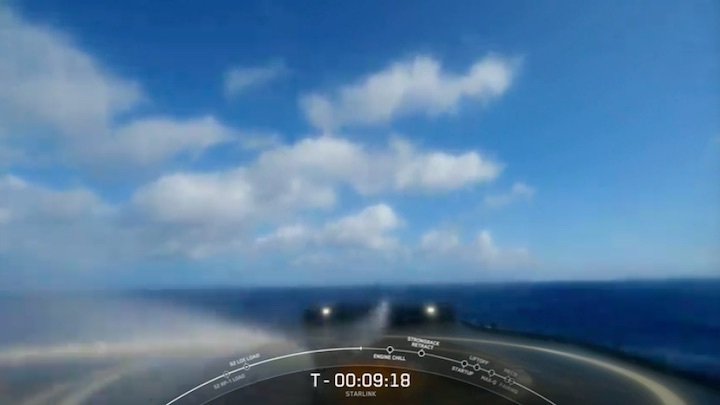
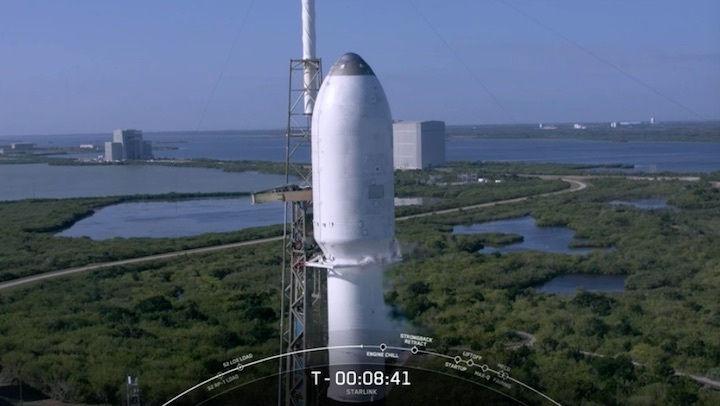
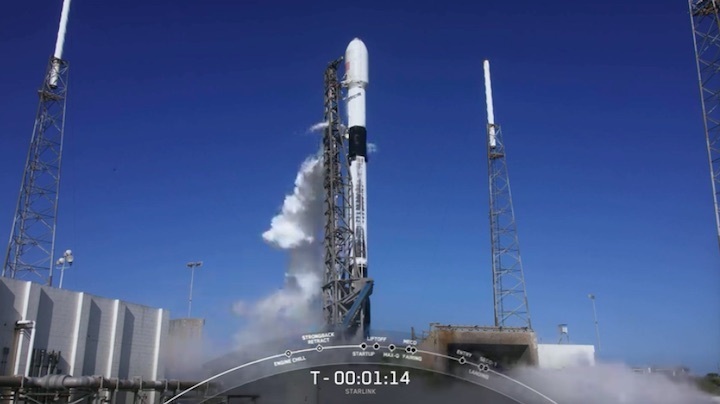

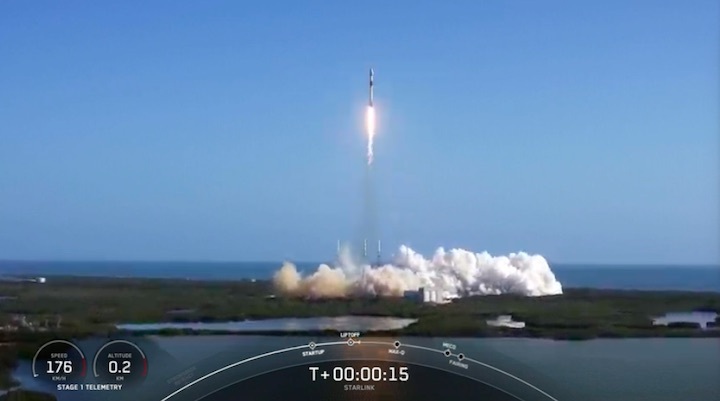






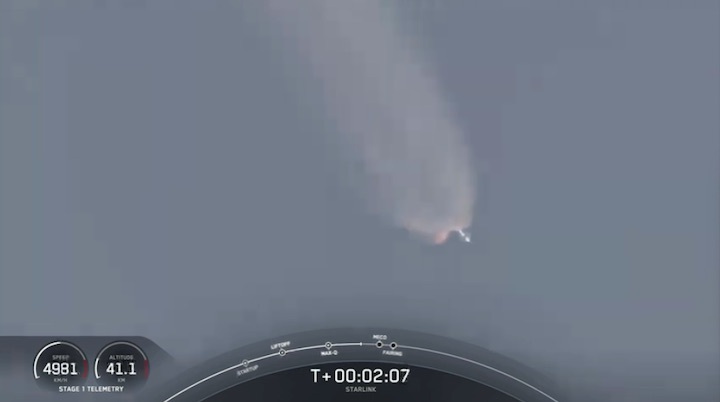






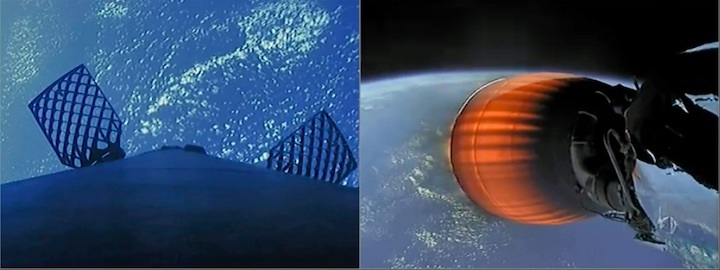
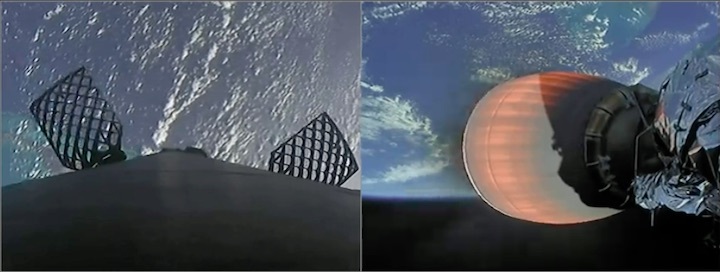





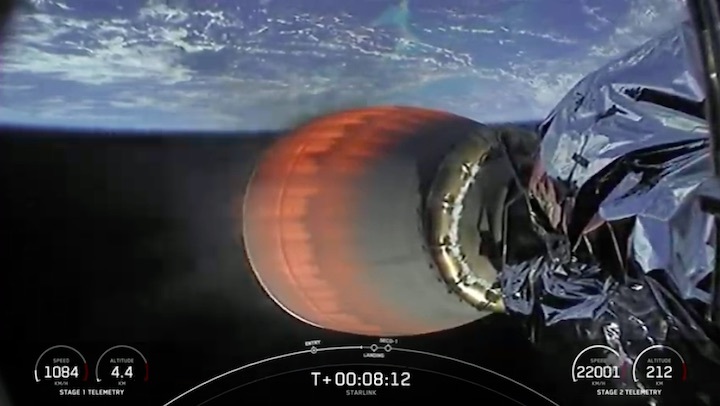
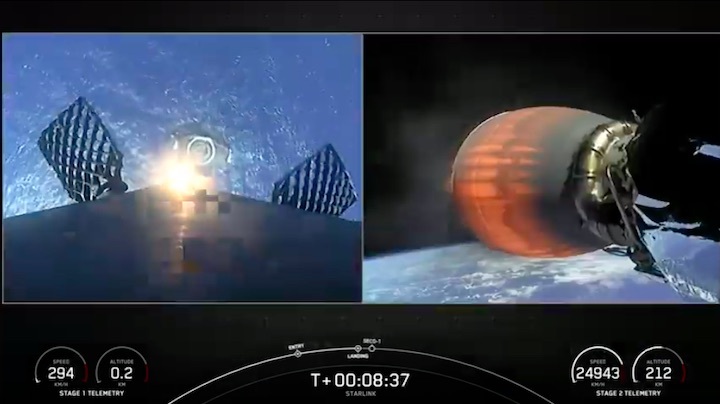




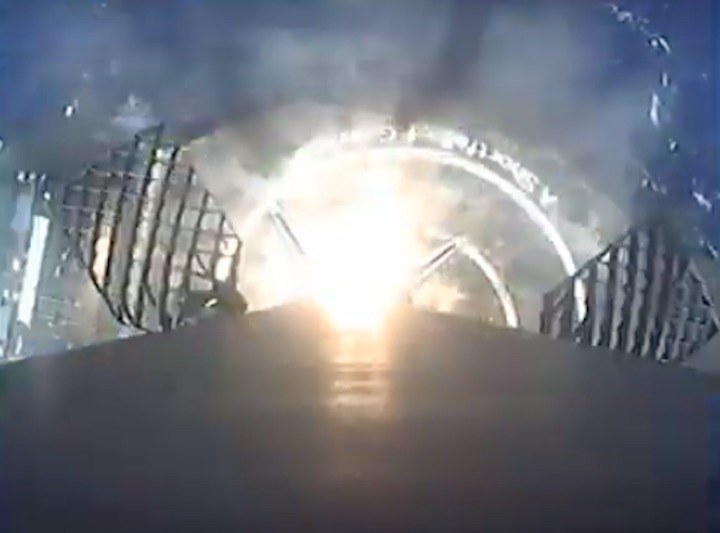




Quelle: SpaceX
+++
Next SpaceX launch to deploy fewer Starlink satellites into higher orbit

A Falcon 9 rocket will launch SpaceX’s next batch of Starlink internet satellites Monday into a higher, more circular orbit than recent flights, reducing potential risks from a solar storm like the one that destroyed at least 38 Starlink craft earlier this month.
SpaceX is set to launch its seventh mission in a little more than seven weeks Monday, with liftoff of a Falcon 9 rocket scheduled for 9:44 a.m. EST (1444 GMT) from pad 40 at Cape Canaveral Space Force Station. SpaceX has two more Falcon 9 rockets scheduled to blast off in the next 10 days from different launch pads in Florida and California.
A stack of 46 flat-packed satellites, each about a quarter-ton in mass, are stowed inside the Falcon 9’s payload fairing for liftoff Monday. SpaceX rolled the Falcon 9 rocket from its hangar out to pad 40, then raised the 229-foot-tall (70-meter) launcher vertical over the weekend.
The payload of 46 satellites is a reduction from the 49 Starlink spacecraft launched on recent flights. The change apparently compensates for mission’s higher altitude target orbit.
There is a 90% chance of favorable weather for launch Monday, according to the U.S. Space Force’s 45th Weather Squadron at Cape Canaveral. Forecasters predict a mostly sunny sky, east winds of 10 to 15 mph, and a temperature of about 72 degrees Fahrenheit at launch time.
SpaceX delayed the mission from Sunday to wait for better weather conditions in the rocket’s offshore landing zone near the Bahamas. A drone ship named “A Shortfall of Gravitas” is in position around 400 miles (650 kilometers) southeast of Cape Canaveral for landing of the first stage booster about nine minutes after liftoff.
The booster is designated B1058 in SpaceX’s inventory of reusable Falcon rocket stages. It will be making its 11th flight Monday, following its debut May 30, 2020, with the launch of NASA astronauts Doug Hurley and Bob Behnken on SpaceX’s first crew mission.
The Falcon 9 will head southeast from Cape Canaveral to place the Starlink satellites into an orbit inclined 53.2 degrees to the equator. SpaceX started launching Starlink satellites on paths to the southeast from Florida last month. The company said it wil launch more Starlink missions to the southeast in the winter months to take advantage of better odds of good weather in the first stage’s landing zone.
Previous Starlink missions launched to the northeast, with booster landings in the Atlantic Ocean east of South Carolina. Launching toward the southeast requires the Falcon 9 rocket to steer around the Bahamas, reducing the number of current generation Starlink satellites the rocket can carry from 52 to 49.
A mission timeline released by SpaceX shows the Falcon 9 rocket’s second stage will fire its engine two times before deploying the Starlink satellites. SpaceX’s recent Starlink missions used a single burn by the second stage engine. This change cuts the number of Starlink satellites carried by the Falcon 9 rocket from 49 to 46.
The second upper stage burn will place the Starlink satellites into a near-circular orbit by raising the altitude of the orbit’s perigee, or lowest point. The target orbit for Monday’s mission will range between 202 miles and 209 miles (325 by 337 kilometers) in altitude.
The previous Starlink mission, which launched Feb. 3, placed 49 satellites into a more oval-shaped, or elliptical, orbit with a perigee about 130 miles (210 kilometers) above Earth.
But a geomagnetic storm triggered by a solar flare led to the destruction of at least 38 of those satellites. The solar flare sent a burst of radiation into the solar system, causing Earth’s atmosphere to warm and swell, leading to more atmospheric drag working against satellites in low Earth orbit.
The 49 Starlink satellites that launched Feb. 3 were especially at risk from the geomagnetic storm because they were flying so close to Earth, at about half the altitude of the International Space Station.
SpaceX ground controllers commanded the new Starlink satellites into safe mode, orienting them to fly edge-on against the atmosphere to minimize drag. But the drag still slowed the satellites’ velocity enough to re-enter the atmosphere, where they were expected to burn up before impacting Earth’s surface.
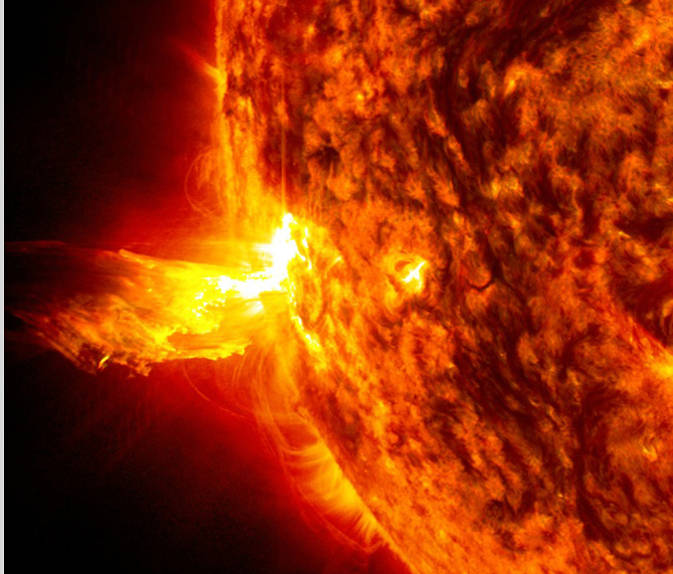
SpaceX typically deploys Starlink satellites into low orbits so they can quickly fall back into the atmosphere if they fail, ensuring they don’t become space junk. Once SpaceX confirms a satellite is healthy, teams send commands to begin orbit-raising into the operational Starlink network using ion engines.
Officials expected up to 40 of the satellites launched Feb. 3 to re-enter the atmosphere after the geomagnetic storm. SpaceX ultimately lost 38 of the 49 new spacecraft, with the remaining 11 now raising their orbits.
There’s also another benefit to launching into a low orbit. A Falcon 9 rocket can haul more Starlink spacecraft on a single mission if it targets a lower altitude.
SpaceX has launched 2,091 Starlink spacecraft since 2018, including prototypes. More than 200 of the satellites have fallen out of orbit after failure or decommissioning, according to a tabulation maintained by Jonathan McDowell, an astrophysicist and expert tracker of spaceflight activity.
McDowell’s chart shows more than 1,500 Starlink satellites are currently operational and providing internet service. SpaceX does not regularly release details about the number of satellites in its active constellation.
SpaceX is in the midst of deploying of around 4,400 Starlink satellites in five orbital “shells” at slightly different altitudes and at different inclinations, or angles to the equator, enough to provide global internet connectivity. The company’s recent launches, including Monday’s mission, have targeted an orbital shell at an inclination of 53.2 degrees and an altitude of 335 miles (540 kilometers).
The company has plans to eventually launch as many as 42,000 Starlink satellites to expand internet coverage, an ambitious goal that could be aided by the start of missions using SpaceX’s next-generation heavy-lift Starship rocket.
SpaceX has two more Starlink missions slated to launch in the next 10 days, with other Falcon 9 rockets due to take off from California and Florida on Feb. 25 and March 3.
Quelle: SN
